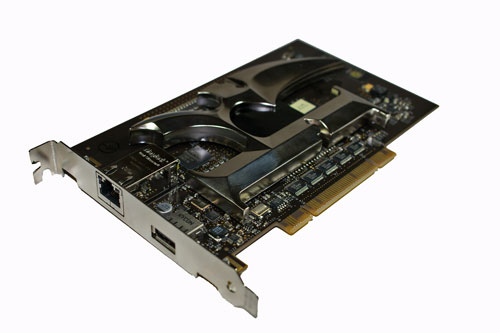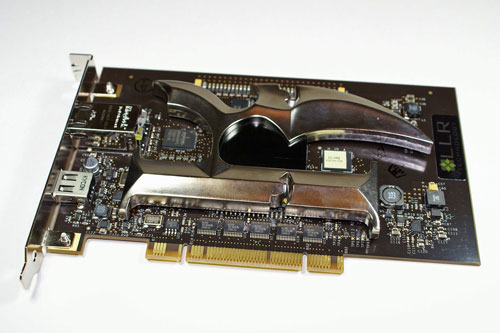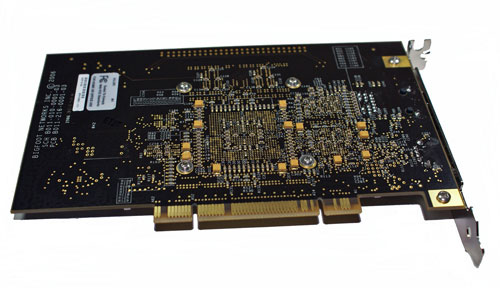BigFoot Networks Killer NIC: Killer Marketing or Killer Product?
by Gary Key on October 31, 2006 2:00 AM EST- Posted in
- Networking
Killer NIC Card
The Killer NIC ships with an installation disc that includes several Linux programs, a few decals, product documentation package, and a full retail copy of F.E.A.R. on DVD.
The Killer NIC is a very interesting card and since the Halloween season is upon us we have to say the thought of removing the "K" heatsink and using it as part of our Blade costume came to mind several different times. The PCB is black in color and contains a significant amount of components that you would never expect to see on a typical NIC. There are also several red LEDs on the PCB whose blinking movements can be adjusted by the control panel. Overall, the card's design theme follows its naming convention.
The card is equipped with a Freescale MPC8347E communications processor, a Xilinx Spartan FPGA, an integrated Broadcom Gigabit PHY, and 64MB of RAM for the embedded Linux build that is accessed by the FNapp Console. The Freescale MPC8347E communications processor is designed for general communications requirements from Ethernet routers to Internet network appliances. The Xilinx Spartan FPGA is a programmable gate array that houses Bigfoot Networks' proprietary and patent pending algorithms that also utilize the 64MB of onboard RAM.

The card utilizes a standard RJ-45 port and includes a USB 2.0 port. The USB 2.0 port is not visible to Windows and is designed to be used by an FNapp. The thought process is that an FNapp can read or write data to a flash drive or external HD. This would be very advantageous for writing data directly to an external hard drive via a BitTorrent type FNapp as one example.
The amount of integrated components along with its basic design features is one of the reasons why this card costs $279.99. This is a price tag that generally puts this card out of reach for most users who are typically satisfied with their NIC's current performance.
The card was very easy to set up. You need to disable your current NIC for optimum performance and compatibility. This is an action that we highly advise after a couple of aborted installs with the original driver set. The card requires a single PCI 2.2 slot and is only compatible with 32-bit Windows XP at this time. After installing the card, a quick reboot, and hardware recognition by XP, you install the driver set off the CD although we highly suggest downloading the latest release first. Another reboot is required and then you are set to use the card for total world domination. Well, at least this is probably your thought process if you read through the marketing material and other documentation online.
Additional 64-bit XP and Linux support is expected within the next six to eight weeks. However, it is still uncertain as to what features will be enabled for Linux and what if any performance benefits will be gained. Windows Vista support should be available by the time the OS ships and it will be interesting to see if there are any improvements considering Microsoft has completely rewritten the network stack code for efficiency and latency reduction. At this point in time there are no plans for a PCI Express version of the Killer NIC. According BigFoot Networks the PCI interface was utilized to improve transactional latencies, programming familiarity, and the fact that most systems have the required amount of PCI slots. We disagree with that last point as the majority of performance oriented boards are now PCI slot starved, and we would expect PCI-E to be a future consideration depending on the success of the current design.
The Killer NIC ships with an installation disc that includes several Linux programs, a few decals, product documentation package, and a full retail copy of F.E.A.R. on DVD.
 |
 |
| Click to enlarge |
The Killer NIC is a very interesting card and since the Halloween season is upon us we have to say the thought of removing the "K" heatsink and using it as part of our Blade costume came to mind several different times. The PCB is black in color and contains a significant amount of components that you would never expect to see on a typical NIC. There are also several red LEDs on the PCB whose blinking movements can be adjusted by the control panel. Overall, the card's design theme follows its naming convention.
The card is equipped with a Freescale MPC8347E communications processor, a Xilinx Spartan FPGA, an integrated Broadcom Gigabit PHY, and 64MB of RAM for the embedded Linux build that is accessed by the FNapp Console. The Freescale MPC8347E communications processor is designed for general communications requirements from Ethernet routers to Internet network appliances. The Xilinx Spartan FPGA is a programmable gate array that houses Bigfoot Networks' proprietary and patent pending algorithms that also utilize the 64MB of onboard RAM.

The card utilizes a standard RJ-45 port and includes a USB 2.0 port. The USB 2.0 port is not visible to Windows and is designed to be used by an FNapp. The thought process is that an FNapp can read or write data to a flash drive or external HD. This would be very advantageous for writing data directly to an external hard drive via a BitTorrent type FNapp as one example.
The amount of integrated components along with its basic design features is one of the reasons why this card costs $279.99. This is a price tag that generally puts this card out of reach for most users who are typically satisfied with their NIC's current performance.
The card was very easy to set up. You need to disable your current NIC for optimum performance and compatibility. This is an action that we highly advise after a couple of aborted installs with the original driver set. The card requires a single PCI 2.2 slot and is only compatible with 32-bit Windows XP at this time. After installing the card, a quick reboot, and hardware recognition by XP, you install the driver set off the CD although we highly suggest downloading the latest release first. Another reboot is required and then you are set to use the card for total world domination. Well, at least this is probably your thought process if you read through the marketing material and other documentation online.
Additional 64-bit XP and Linux support is expected within the next six to eight weeks. However, it is still uncertain as to what features will be enabled for Linux and what if any performance benefits will be gained. Windows Vista support should be available by the time the OS ships and it will be interesting to see if there are any improvements considering Microsoft has completely rewritten the network stack code for efficiency and latency reduction. At this point in time there are no plans for a PCI Express version of the Killer NIC. According BigFoot Networks the PCI interface was utilized to improve transactional latencies, programming familiarity, and the fact that most systems have the required amount of PCI slots. We disagree with that last point as the majority of performance oriented boards are now PCI slot starved, and we would expect PCI-E to be a future consideration depending on the success of the current design.










87 Comments
View All Comments
WileCoyote - Friday, November 3, 2006 - link
I said it's too wordy. That means take out words. Are you people for real?Frumious1 - Tuesday, October 31, 2006 - link
That post was too short. Three sentences with no real support to back it up. Lamest comment ever.Look, sorry you have poor reading skillz, but a lot of us are quite educated and like to know the WHY and HOW besides just the WHAT. My first thought was "how in the hell is this product supposed to do ANYTHING for frame rates!?" Gary answered that by looking into the details more than superficially. Oh, sure, it doesn't really deliver -- a 5% increase on a moderately high-end system is pretty silly for a $270 product -- but that it can affect frame rates at all is surprising to me. I now have hope for Windows Vista, at least on the networking stack side of things.
What's really odd is that the review is pretty clearly advising people to NOT go out and buy this "killer" product, because it just isn't that great. If I saw a review on AnandTech that bashed a product without any backing material, I'd feel I was reading something at HardOCP. Well, okay, they back up their complaints sometimes, but their testing methodology is worse than suspect. Remember the Core 2 "launch" reviews where they used a midrange GPU config to conclude that it did nothing for gaming performance?
Anyway, there seem to be quite a few new names on here for this article. Wonder how many are employed by BigFoot? It's like there are a bunch of people bashing Gary for even reviewing the product at all, another group that's bashing him for not liking the card, a third group bashing him for not being able to do a 1 page writeup, and then a few people that think: "nice review; didn't surprise me much with the results, but at least we can now know that Killer can help in certain situations, even if it's overpriced as hell."
I'm sure Gary was tested a lot more than is shown in this article. I've conversed with him in the past, and I'd wager he was pulling his hair out over this article. How many times did you write it Gary? Ten? More? I think you ought to post here and set the record straight, because my bet is that in terms of improving gaming performance the Killer NIC is as good as a NIC is going to get... which means the other NICs from Intel, 3COM, etc. are basically all as good as onboard solutions if that. There's really not much you can do to truly improve performance of a NIC for online gaming when you're looking at maybe 5ms worst case being delay added by the hardware and OS.
As I said above in an earlier comment, it would be nice to have more developers like Jon Carmac around, because he apparently knows how to already perform well without lots of extra hardware. Can't say his games are the greatest, but the Doom 3 engine and networking aspects (client/server architecture) are clearly ahead of most other FPS solutions.
WileCoyote - Wednesday, November 1, 2006 - link
I was trying to keep my comment short, simple, and to the point. I don't need to write a page defending my opinion on something as trivial as a product review. The numbers speak for themselves in this review. And it wasn't so much the quantity but rather the quality - there is little to no structure in the review. That's fact, not opinion. There is a better way to write a review - I've read hundreds of them on Anandtech.I guess my Bachelor's Degree in Anthropology from a well-respected U.S. university doesn't count for much and neither does the successful business I created/own which pays a six-figure salary.
Gary Key - Wednesday, November 1, 2006 - link
Apparently my MBA and the fact I am already retired (at 44 and doing this because I really enjoy it) does not count for very much either. LOL.....
Seriously, I am always looking to improve. How would you change the structure of the article?
Aikouka - Tuesday, October 31, 2006 - link
Being that I run an FTP server that tends to see a decent amount of internal traffic, it actually sounds like a TNIC (or simply making a dedicated server) could actually be beneficial to me. Although, I sure have no desire to pay $300 for that card when I could easily spend the money on a second video card for SLi purposes or such. Also, I know switching from single to dual-core really helped to off-set the issue of FTP uploading on the local intranet. It really won't matter as when I build a new PC next month, I'm simple setting my old PC as a dedicated server to offload those annoying tasks.Also, Mlau, there are some games where "real estate" matters. World of Warcraft is a great example of this and I'm glad that I play the game in 1650x1080, because in certain situations, there's so much junk on your screen (I may call it junk but it actually helps :P), that you need all the extra room you can get. You may be happy in 1024x768, but that gives you no right to vehemently demean people for wanting to play in higher resolutions, which doing so also provides a better quality picture without wasting resources on Anti-Aliasing. Almost all the time, enjoying a game the way the developers designed/envisioned it can be an enriching experience for the gamer.
Gary, your comment about WoW being limited to 64 FPS... I think you may've left Vertical Sync on :D. I can easily get 90FPS on my dated Athlon 64 X2 4400+ with a GeForce 6800GT OC playing in 1650x1080 with max graphics settings. Albeit, I don't get a constant 90FPS, but it can be easily attainable in non-expansive places. So yeah, if your refresh rate on your LCD/CRT was set to 60Hz, you probably would see your game hover around 60-64FPS or somwhere between that and 30FPS. I know I turned VSync off on mine as I couldn't constantly achieve 60FPS, so the game lowered my FPS to about 30 with VSync turned on. Simply turning it off raised me to an easy 45 minimum with no tearing evident. I know that in the Hillsbrad/Alterac area, I would probably get around 45-60 depending on how far into the distance I could see.
Gary Key - Wednesday, November 1, 2006 - link
http://forums.worldofwarcraft.com/thread.html;jses...">Blizzard ResponseHi,
We tried your suggestions during testing and nothing helped. We used both LCD and CRT monitors with vsync off. This was with several different video cards and Core 2 Duo/AM2 X2 processors. The frame rates were always capped to 64 until we switched to a single core processor on either system. We contacted Blizzard directly and they confirmed the dual core bug. The link above has their response on line item 6. Are you using FRAPS to capture the frame rates? If so which version please?
Thanks!!!
goinginstyle - Thursday, November 2, 2006 - link
I downloaded FRAPS 2.81 and sure enough my 4800+ X2 is capped at 64FPS.otherwise - Tuesday, October 31, 2006 - link
You can get an 10/100 ethernet card with a TOE dirt cheap for much less then $300 if you really want one. With most people who actuially need a TOE also demanding 10/100/1000 support, there is a glut of 10/100 TOE NICs.dijuremo - Tuesday, October 31, 2006 - link
You will probably get more out of $300 if you get a hardware raid controller for your system (Areca comes to mind) which will not only provide a speed upin storage, but also redundancy for your system. I know it does nothing for your network performance, but is money better spent which is my point.I considered getting a Killer NIC for my new system, but did not do it because of price, no PCI-Express support (Mobo only has 2 PCI slots used for sound card and HDTV tuner and has 4 PCI Express slots, one used currently for Nvidia 7950GX2), plus performance gains were not that good (I read another review of this card about a month ago elsewhere).
As for the person saying sli/xfire is useless, you are totally wrong. At 1920x1080 (using the LVM-37w3 LCD monitor - 1080p native) you need sli or xfire to have decent speeds to play games with AA and AF. If you don't play games or play at 1280x1024 or less it does not matter, but above that you really need sli or xfire.
I also agree the article was a bit too long and actually more effective that a Lunesta overdose. Not sure if the writer is trying to avoid what just happened to HEXUS where they reviewed an Alienware PC and got e-mail back from the company saying they would not get any more harware because of the bad review...
heated snail - Tuesday, October 31, 2006 - link
I don't mean to be a jerk, and I appreciate any sincere and fact-finding test/review article. However:I'm amazed, was this really a review of a basic hardware item? Because instead it reads like a mini-novel about all the difficulty the testers/reviewers had in doing their job. Is it too much to ask for a more verbally efficient writing style? About two paragraphs briefly acknowledging that this product has been hyped in the media, and acknowledging that testing was a little more difficult than usual... then get straight to the tests on page two and conclusions on page three. I can't believe how long it took to read through this whole thing with its very repetitive descriptions and self-references.